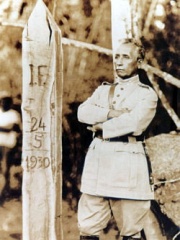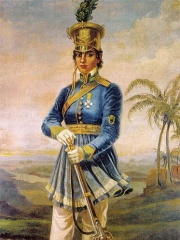



The Most Famous
MILITARY PERSONNELS from Brazil
This page contains a list of the greatest Brazilian Military Personnels. The pantheon dataset contains 2,058 Military Personnels, 4 of which were born in Brazil. This makes Brazil the birth place of the 57th most number of Military Personnels behind Slovenia, and North Macedonia.
Top 4
The following people are considered by Pantheon to be the most legendary Brazilian Military Personnels of all time. This list of famous Brazilian Military Personnels is sorted by HPI (Historical Popularity Index), a metric that aggregates information on a biography's online popularity.

1. Cândido Rondon (1865 - 1958)
With an HPI of 59.18, Cândido Rondon is the most famous Brazilian Military Personnel. His biography has been translated into 22 different languages on wikipedia.
Marshal Cândido Mariano da Silva Rondon (5 May 1865 – 19 January 1958) was a Brazilian military officer most famous for his telegraph commission and exploration of Mato Grosso and the western Amazon basin, as well as his lifelong support for Indigenous Brazilians. He was the first director of Brazil's Indian Protection Service or SPI (later FUNAI) and supported the creation of the Xingu National Park. The Brazilian state of Rondônia is named after him.

2. Maria Quitéria (1792 - 1853)
With an HPI of 58.44, Maria Quitéria is the 2nd most famous Brazilian Military Personnel. Her biography has been translated into 21 different languages.
Maria Quitéria de Jesus (27 July 1792 – 21 August 1853) was a Brazilian soldier and national heroine. She served in the Brazilian War of Independence in 1822–24 dressed as a man. She was promoted to cadet and lieutenant and later decorated with the Imperial Order of the Cross. Quitéria has been called the "Brazilian Joan of Arc", and has become a legendary figure in Brazil. Quitéria was the first woman to serve in a military unit in the country. She is known as one of the three Bahia women fighters against the Portuguese along with Maria Filipa de Oliveira (died 1873) and Sister Joana Angélica (1761-1822). Against her father's will, an unmarried Maria Quitéria enlisted in the Parakeet Battalion, division of the Brazilian Army, as a man, in October 1822. Until June 1823, she fought in several battles against the Portuguese in Bahia, where she lived. Maria Quitéria's father outed her as a woman once he discovered her betrayal—but because of her skill in battle, she was allowed to continue to fight. She was promoted to cadet in July 1823, and then to lieutenant in August, where she was received and decorated by the Emperor. Few details are known about her life. The historian Aristides Augusto Milton, a childhood friend of the poet Castro Alves, who in turn was a grandson of the major who defended Maria Quitéria for her skill with weapons and recognized military discipline, and incorporated it her to his troops, considered Maria Quitéria "a lady as brave as honest" in his Efemérides Cachoeiranas. She is briefly mentioned by English traveler and writer Maria Graham (later Lady Callcott) in her book Journal of a Voyage to Brazil: "Maria de Jesus is illiterate, but lively. She has clear intelligence and acute perception. I think that if they educated her, she would become a notable personality. One observes nothing masculine in her conduct, rather she is of gentle and friendly manners."

3. Aurélio de Lira Tavares (1905 - 1998)
With an HPI of 55.67, Aurélio de Lira Tavares is the 3rd most famous Brazilian Military Personnel. His biography has been translated into 18 different languages.
Aurélio de Lira Tavares (7 November 1905 – 18 November 1998) was a general in the Brazilian Army. He was one of the military in the joint military board that ruled Brazil between the illness of Artur da Costa e Silva in August 1969 and the investiture ceremony of Emílio Garrastazu Médici in October of that same year. During the government of the junta, the American ambassador to Brazil Charles Burke Elbrick was kidnapped by the communist guerrilla group Revolutionary Movement 8th October — radical opposition to the military dictatorship.

4. Márcio Melo (1906 - 1991)
With an HPI of 54.99, Márcio Melo is the 4th most famous Brazilian Military Personnel. His biography has been translated into 15 different languages.
Márcio de Sousa e Melo (26 May 1906 – 31 January 1991) was a general with the Brazilian Air Force. Melo was one of the military in the joint military board that ruled Brazil between the illness of Artur da Costa e Silva in August 1969 and the investiture ceremony of Emílio Garrastazu Médici in October of that same year. During the government of the junta, the American ambassador to Brazil Charles Burke Elbrick was kidnapped by the communist guerilla group Revolutionary Movement 8th October — radical opposition to the military dictatorship.
People
Pantheon has 4 people classified as Brazilian military personnels born between 1792 and 1906. Of these 4, none of them are still alive today. The most famous deceased Brazilian military personnels include Cândido Rondon, Maria Quitéria, and Aurélio de Lira Tavares.
Deceased Brazilian Military Personnels
Go to all RankingsCândido Rondon
1865 - 1958
HPI: 59.18
Maria Quitéria
1792 - 1853
HPI: 58.44
Aurélio de Lira Tavares
1905 - 1998
HPI: 55.67
Márcio Melo
1906 - 1991
HPI: 54.99
Overlapping Lives
Which Military Personnels were alive at the same time? This visualization shows the lifespans of the 4 most globally memorable Military Personnels since 1700.

